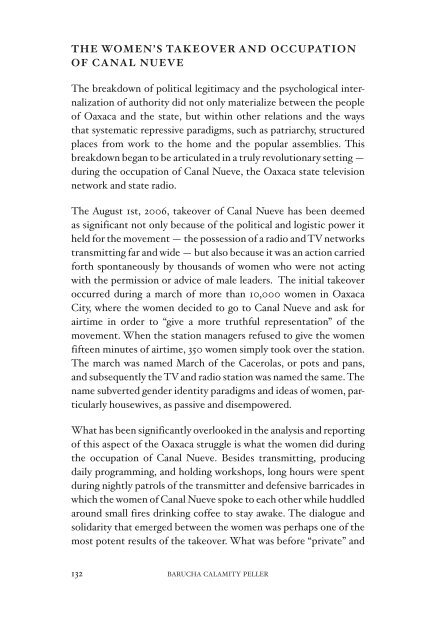Lies: A Journal of Materialist Feminism - Libcom
Lies: A Journal of Materialist Feminism - Libcom
Lies: A Journal of Materialist Feminism - Libcom
You also want an ePaper? Increase the reach of your titles
YUMPU automatically turns print PDFs into web optimized ePapers that Google loves.
THE WOMEN’S TAKEOVER AND OCCUPATION<br />
OF CANAL NUEVE<br />
The breakdown <strong>of</strong> political legitimacy and the psychological internalization<br />
<strong>of</strong> authority did not only materialize between the people<br />
<strong>of</strong> Oaxaca and the state, but within other relations and the ways<br />
that systematic repressive paradigms, such as patriarchy, structured<br />
places from work to the home and the popular assemblies. This<br />
breakdown began to be articulated in a truly revolutionary setting —<br />
during the occupation <strong>of</strong> Canal Nueve, the Oaxaca state television<br />
network and state radio.<br />
The August 1st, 2006, takeover <strong>of</strong> Canal Nueve has been deemed<br />
as significant not only because <strong>of</strong> the political and logistic power it<br />
held for the movement — the possession <strong>of</strong> a radio and TV networks<br />
transmitting far and wide — but also because it was an action carried<br />
forth spontaneously by thousands <strong>of</strong> women who were not acting<br />
with the permission or advice <strong>of</strong> male leaders. The initial takeover<br />
occurred during a march <strong>of</strong> more than 10,000 women in Oaxaca<br />
City, where the women decided to go to Canal Nueve and ask for<br />
airtime in order to “give a more truthful representation” <strong>of</strong> the<br />
movement. When the station managers refused to give the women<br />
fifteen minutes <strong>of</strong> airtime, 350 women simply took over the station.<br />
The march was named March <strong>of</strong> the Cacerolas, or pots and pans,<br />
and subsequently the TV and radio station was named the same. The<br />
name subverted gender identity paradigms and ideas <strong>of</strong> women, particularly<br />
housewives, as passive and disempowered.<br />
What has been significantly overlooked in the analysis and reporting<br />
<strong>of</strong> this aspect <strong>of</strong> the Oaxaca struggle is what the women did during<br />
the occupation <strong>of</strong> Canal Nueve. Besides transmitting, producing<br />
daily programming, and holding workshops, long hours were spent<br />
during nightly patrols <strong>of</strong> the transmitter and defensive barricades in<br />
which the women <strong>of</strong> Canal Nueve spoke to each other while huddled<br />
around small fires drinking c<strong>of</strong>fee to stay awake. The dialogue and<br />
solidarity that emerged between the women was perhaps one <strong>of</strong> the<br />
most potent results <strong>of</strong> the takeover. What was before “private” and<br />
132<br />
BARUCHA CALAMITY PELLER

















